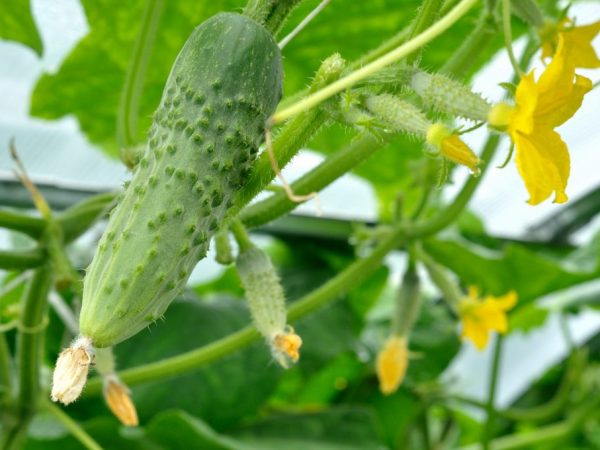Characteristics of Lenara cucumbers
The Lenara cucumber variety belongs to the novelties in the market of goods for gardeners. Gherkin type cucumber, the seeds of which are produced by the Dutch company Rijk Zwaan. The variety gives high yield rates. They grow both private vegetable growers and small farms.

Characteristics of Lenara cucumbers
Description of the variety
Cucumber Lenara F1 - a hybrid with a powerful root system, which forms short, but strong lateral shoots.
Fruit weight reaches 120 grams, length - up to 13 cm, diameter - 3 cm, about the same size. The cucumber has a cylindrical shape, a dark green shade, light stripes along the length, a dense structure inside, the skin is not thick, it has a good taste without bitterness. Spines are white, infrequent. Cucumbers are more suitable for salad.
Advantages and disadvantages
Positive indicators of the Lenara variety:
- High yield
- Resistant to sudden temperature changes
- Self-pollinating
- Presentable look for sale
- Early ripening due to the seedling method of planting
- Keeps fresh for a long time
- Easy transportation
- Sufficiently resistant to many ailments and pests. For example, it is resistant to such shkodniks as powdery mildew, cladosporium and cucumber mosaic virus.
- Grows well in the shade
There are also some drawbacks of cucumbers of this variety: you need to consume Linar only fresh, if you do not pick it in time, then the fruit will not melt tasty. This type of cucumber often infects aphids.
Planting varieties
Planting of cucumber Lenara F1 is carried out both in greenhouses and in open areas of soil. After the sprouts of the seedlings are strengthened, 3-4 leaves are allowed, they are transplanted to a permanent place. Before this, the soil is recommended to be fertilized and watered. This achieves the maximum yield. For the next 2-3 days, the temperature in the growing environment should be kept at 20 degrees Celsius. The end of January is the most suitable period for planting seedlings in greenhouses, and Lenar's cultivation in open areas begins in mid-May.
Planting seedlings using the trellis method will help to facilitate harvesting and grow a healthy culture. The normal gap between the trellis is 100-120 cm, between the funnels - 40-45 cm. The main stem is pinched.
Thanks to such properties of Lenara F1 cucumber as good adaptation to growing conditions and fast regeneration, the variety is optimally suited for growing both in summer and in autumn.
Care

The plant needs regular watering
For good growth of the cucumber bush Lenara F1, the following conditions are needed:
- Regular weeding of the soil
- Top dressing
- Timely and generous watering
To prevent damage to the roots, areas are weeded with extreme care. Watering is carried out in the evening with warm water (the culture does not tolerate cold water) every 6-8 days before flowering, every 3-4 days after the appearance of flowers. Insufficient watering will lead to a loss of taste, the fruits will dry out and taste bitter. Also, a good harvest will be provided by mineral and organic fertilizers. They are recommended to be used 5-6 times per season, because the bushes constantly bear fruit.It is necessary to plant the planting not too thickly and pick the fruits in a timely manner.
Pest control
Gardeners, growing this variety, often face the problem of damage to the fruits of aphids. When this disease is affected, the leaves curl and the flowers fall off. To prevent aphids from causing significant damage to the crop, you can use folk remedies:
- For a bucket of water - 400 g of makhorka and 80 g of laundry soap, let it brew for a day. Sprinkle cucumber bushes with the resulting liquid 1-2 times a week.
- Pour half a bucket of onion peel with 10 liters of hot water, let it brew for a day. Strain and dilute in a 1: 2 ratio. After that, process the culture.
- For 1 liter of boiling water, give 50 g of red chilli pepper. Let it brew for two hours. Add water to bring the volume of the solution to 10 liters. Nim to spray the bushes.
If folk remedies do not work, you can use stronger methods - chemicals. "Decis", "Metofos", etc. are suitable for disinfection of hotbeds and greenhouses. The bushes are treated three weeks before harvest with the preparations "Decis", "Arrivo", "Kinmiks" or "Intavir".
Conclusion
The description, together with the reviews of the gardeners, give a positive picture in the review of the variety. Its cultivation has established itself as an excellent process. The characteristic is that over time the variety is gaining more and more fans among amateur summer residents and professionals in their field. Its versatility and ability to adapt to a variety of conditions have made it one of the most popular.


